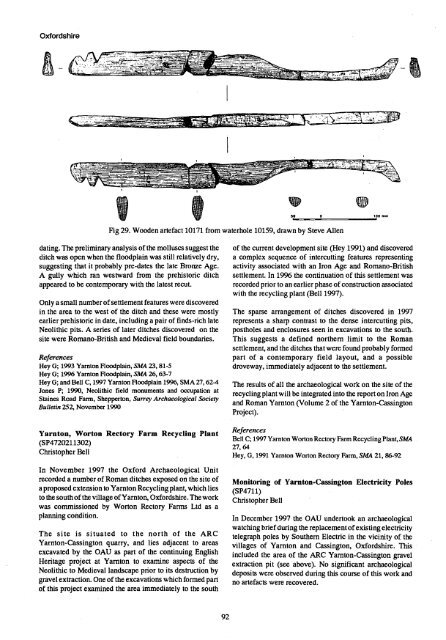CBA SMA\SMA 1998.PDF - Council for British Archaeology
CBA SMA\SMA 1998.PDF - Council for British Archaeology
CBA SMA\SMA 1998.PDF - Council for British Archaeology
You also want an ePaper? Increase the reach of your titles
YUMPU automatically turns print PDFs into web optimized ePapers that Google loves.
Ox<strong>for</strong>dshire<br />
50 100 mon<br />
Fig 29. Wooden artefact 10171 from waterhole 10159, drawn by Steve Allen<br />
dating. The preliminary analysis of the molluscs suggest the<br />
ditch was open when the floodplain was still relatively dry,<br />
suggesting that it probably pre-dates the late Bronze Age.<br />
A gully which ran westward from the prehistoric ditch<br />
appeared to be contemporary with the latest recut.<br />
Only a small number of settlement features were discovered<br />
in the area to the west of the ditch and these were mostly<br />
earlier prehistoric in date, including a pair of finds-rich late<br />
Neolithic pits. A series of later ditches discovered on the<br />
site were Romano-<strong>British</strong> and Medieval field boundaries.<br />
References<br />
Hey G; 1993 Yarnton Floodplain, SMA 23, 81-5<br />
Hey G; 1996 Yarnton Floodplain, SMA 26,63-7<br />
Hey G; and Bell C, 1997 Yarnton Floodplain 1996, SMA 27,62-4<br />
Jones P; 1990, Neolithic field monuments and occupation at<br />
Staines Road Farm, Shepperton, Surrey Archaeological Society<br />
Bulletin 252, November 1990<br />
Yarnton, Worton Rectory Farm Recycling Plant<br />
(SP4720211302)<br />
Christopher Bell<br />
In November 1997 the Ox<strong>for</strong>d Archaeological Unit<br />
recorded a number of Roman ditches exposed on the site of<br />
a proposed extension to Yarnton Recycling plant, which lies<br />
to the south of the village of Yarnton, Ox<strong>for</strong>dshire. The work<br />
was commissioned by Worton Rectory Farms Ltd as a<br />
planning condition.<br />
The site is situated to the north of the ARC<br />
Yarnton-Cassington quarry, and lies adjacent to areas<br />
excavated by the OAU as part of the continuing English<br />
Heritage project at Yarnton to examine aspects of the<br />
Neolithic to Medieval landscape prior to its destruction by<br />
gravel extraction. One of the excavations which <strong>for</strong>med part<br />
of this project examined the area immediately to the south<br />
of the current development site (Hey 1991) and discovered<br />
a complex sequence of intercutting features representing<br />
activity associated with an Iron Age and Romano-<strong>British</strong><br />
settlement. In 1996 the continuation of this settlement was<br />
recorded prior to an earlier phase of construction associated<br />
with the recycling plant (Bell 1997).<br />
The sparse arrangement of ditches discovered in 1997<br />
represents a sharp contrast to the dense intercutting pits,<br />
postholes and enclosures seen in excavations to the south.<br />
This suggests a defined northern limit to the Roman<br />
settlement, and the ditches that were found probably <strong>for</strong>med<br />
part of a contemporary field layout, and a possible<br />
droveway, immediately adjacent to the settlement.<br />
The results of all the archaeological work on the site of the<br />
recycling plant will be integrated into the report on Iron Age<br />
and Roman Yamton (Volume 2 of the Yarnton-Cassington<br />
Project).<br />
References<br />
Bell C; 1997 Yarnton Worton Rectory Farm Recycling Plant, SMA<br />
27, 64<br />
Hey, G, 1991 Yamton Worton Rectory Farm, SMA 21, 86-92<br />
Monitoring of Yarnton-Cassington Electricity Poles<br />
(SP4711)<br />
Christopher Bell<br />
In December 1997 the OAU undertook an archaeological<br />
watching brief during the replacement of existing electricity<br />
telegraph poles by Southern Electric in the vicinity of the<br />
villages of Yarnton and Cassington, Ox<strong>for</strong>dshire. This<br />
included the area of the ARC Yarnton-Cassington gravel<br />
extraction pit (see above). No significant archaeological<br />
deposits were observed during this course of this work and<br />
no artefacts were recovered.<br />
92

















